When you are learning to play chords – especially 7th chords – it’s very likely you will start with four-way close voicings. The term four-way close (or four-way closed) reflects the fact that the four notes of the chord are close together; within an octave. Four-way close voicings have a smooth sound. An approach to making four-way close voicings that sound both pretty and full is to use an approach called drop 2.
Deriving drop 2 chords
Let’s look at an example. Here’s a standard four-note close voicing for Amaj7 with the root on the 4th string.
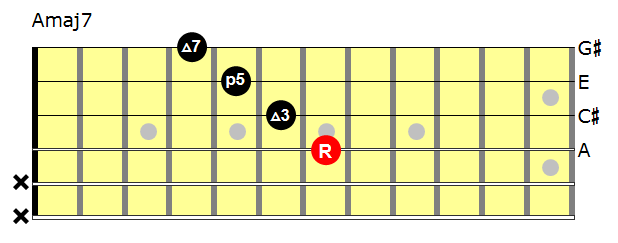
Here we have the notes of the Amaj7 chord in order: root, 3rd, 5th and 7th (or 1-3-5-7 if you prefer). From this starting position we can construct a drop 2 voicing by dropping the second highest note in the chord down an octave. In this case it’s the perfect 5th (E).
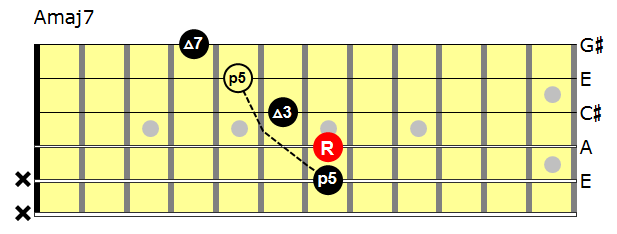
Now what you end up with is pretty much impossible to play – at least for me – so to make things easier we can make it a four-way closed voicing by moving the major seventh (G#) from the first string 4th fret to the second string 9th fret.
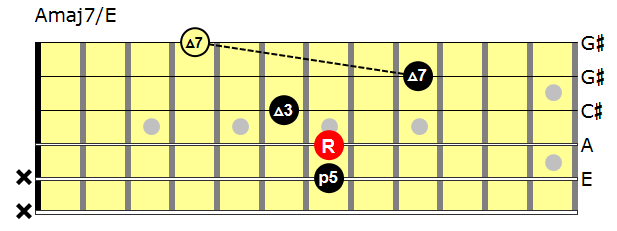
We now have a nice drop 2 voicing for Amaj7 in 6th position on the second string set (strings 2 to 5). Notice we now have the 5th in the bass – the E on the 5th string – so this is a second inversion of Amaj7 (first inversion would have the 3rd in the bass), or Amaj7/E if you prefer.
What we can do next is take the same notes and move them over a string to the first string set (strings 1 to 4) which drops the fingering down to 2nd position. We’ve got exactly the same chord – a drop 2 voicing of Amaj7 in 2nd inversion – but on a different set of strings.
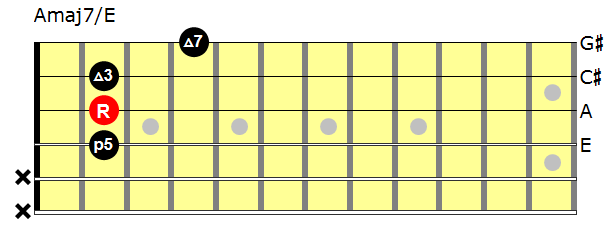
Deriving other inversions
Let’s continue to work on the first string set (strings 1 to 4). What we can now do is progressively move the notes up neck to discover the other inversions of Amaj7. If we take each note of the chord in turn and move up to the next interval we should end up with a new inversion. For example, we can take the perfect 5th (E) and move it up to the next interval, the major 7th (G#). If we repeat for the remaining notes we get a new inversion: Amaj7/G#.
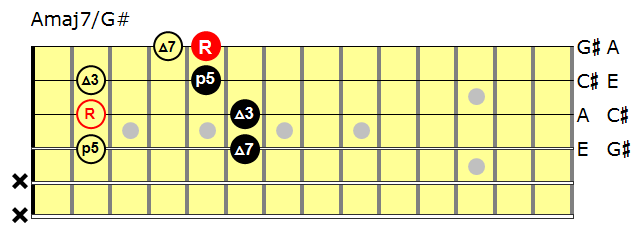
We can repeat this process to discover the remaining 2 inversions of Amaj7. The next one has the root note (A) in the bass.

The next one is the first inversion with the major 3rd (C#) in the bass.
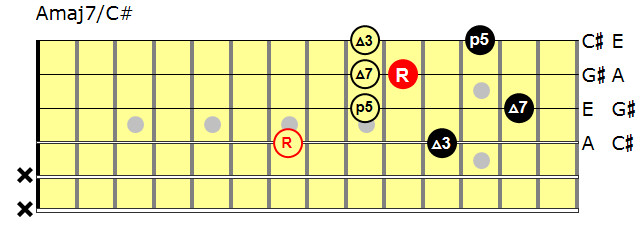
Summary
So, here are the 4 drop 2 Amaj7 chords we have created with each voicing represented by a different colour.
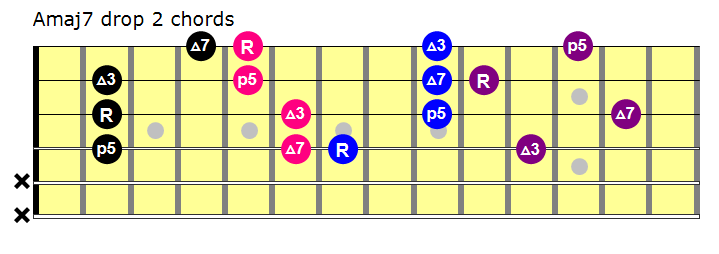
In summary, the following table shows what we’ve got.
| Chord name | Intervals | Notes | Bass note |
|---|---|---|---|
| Amaj7/E | 5-1-3-7 | E – A – C# – G# | Perfect 5th (E) |
| Amaj7/G# | 7-3-5-1 | G# – C# – E – A | Major 7th (G#) |
| Amaj7/A | 1-5-7-3 | A – E – G# – C# | Root (A) |
| Amaj7/C# | 3-7-1-5 | C# – G# – A – E | Major 3rd (C#) |
That’s it! The basic approach to creating drop 2 chords for guitar.
See also
- Drop 2 chord library (Part 1) – A post showing maj7, min7, dom7 and min7b5 drop 2 chords on string 1 to 4.
- Drop 2 chord library (Part 2) – A post showing maj7, min7, dom7 and min7b5 drop 2 chords on string 2 to 5.
- Drop 2 chord library (Part 3) – A post showing maj7, min7, dom7 and min7b5 drop 2 chords on string 3 to 6.
